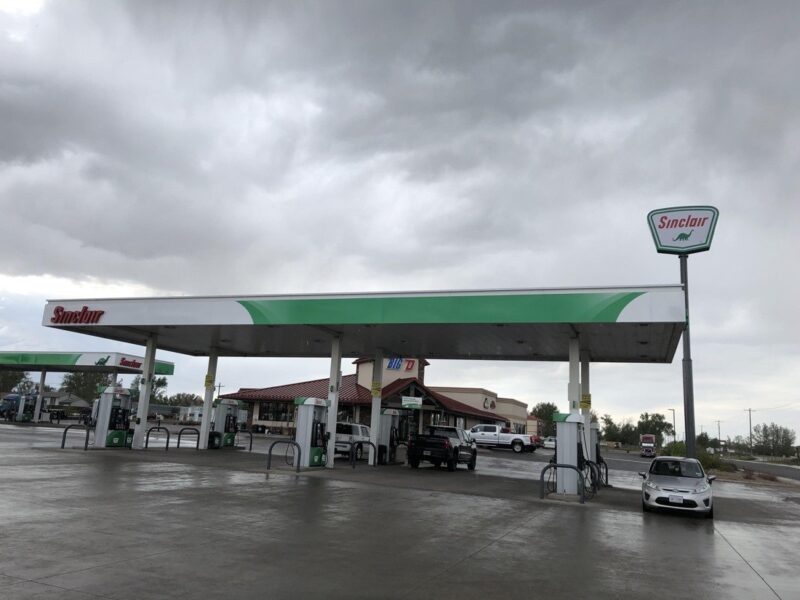Energy Industry Stakeholders Say More Supply is Needed to Lower Fuel Costs
Newly formed working group brainstorming ways to combat high pump prices
- Published In: Other News & Features
- Last Updated: Jul 18, 2022

Pictured above is a Sinclair gas station in Laramie, Wyoming. A newly formed state gas and diesel price working group is seeking solutions for lowering fuel costs. (Wyoming Truth photo by Shen Wu Tan)
By Shen Wu Tan
Special to the Wyoming Truth
A solution to address Wyoming’s soaring gas prices is unclear, but energy industry stakeholders who spoke to a newly formed working group agreed about one thing: the need to increase supply.
“We need a sustained supply in Wyoming; right now, we don’t have it, in my opinion,” John Dooley, owner of Dooley Oil Inc., told the gas and diesel price working group at its first public meeting Friday. “The number one issue that we have is we need to increase our reliable sources in Wyoming for fuel.”
The working group, established by Gov. Mark Gordon last month to brainstorm ways to combat rising fuel costs, received input about oil and gas production in the state, market forces affecting fuel costs and state fuel taxes.
Wyoming’s ability to produce fuel has decreased, energy industry experts emphasized.
The number of operating refineries in Wyoming has declined as the state’s population has climbed, according to a meeting presentation by Dooley Oil Inc. and Triple C Enterprises. In 1978, Wyoming had 12 operating refineries; by 2015, that number dropped to six. This year, there are only three operating refineries in the state, the presentation data shows.
However, Wyoming’s population moved in the opposite direction, growing from 432,889 in 1978 to 577,267 in 2021.
The data also shows there were 6,444 vehicles per day on I-80 in 1980. That figure has nearly doubled to 13,000 vehicles per day in 2021 and is projected to reach 27,357 per day by 2032.
Steve Cure, an energy consultant for Triple C Enterprises, told the working group that the entire Rocky Mountain region is experiencing an energy supply deficit.
“We are running short of refined products,” Cure said. “All of the refineries that have closed have closed permanently because no new refinery has been built in the U.S. in over 50 years. So the refineries that were closing were banded together and held together with duct tape, and they just couldn’t keep them operating. They shut them down because it wasn’t feasible to continue to operate them in the downturn as supply came off.”
Even if a new refinery is built, Cure estimates it would take seven years until fuel could be sold. He said solutions to rising fuel prices are to increase supply and refining capacity, as well as explore other options to bring fuel into the region.
In addition to lower domestic supply of fuel, Cure noted that energy prices also have been impacted by the Ukraine war, government spending, inflation, the green policy push and increased travel.
The average gas price in Wyoming as of Monday morning was $4.71 per gallon, according to GasBuddy. This price is down five cents from the previous week’s average of $4.76 and down 10.7 cents from last month’s average of $4.82. Yet, the average price is up $1.31 from last year’s average of $3.40, GasBuddy data shows.
Pete Obermueller, president of the Petroleum Association of Wyoming, told the working group that the state’s refining capacity has decreased by 26%. But he noted the state only accounts for 0.7% of the refining capacity in the United States.
“For better or worse, Wyoming is part of a global market,” Obermueller said. “We’re a player, a small player, but a player in the global market, and when those supply shocks happen on the crude side it ripples down…But in terms of correcting the price at the pump, it is a supply-and-demand problem now, and there has to be a supply-and-demand solution to that as well.”
One possible idea for lowering gas prices floated during the meeting: a temporary fuel tax holiday.
State gas and diesel taxes in Wyoming are 24 cents per gallon, which is lower than most surrounding states, Wyoming Department of Transportation Director Luke Reiner said. The fuel taxes collected go toward road-related expenses, such as repairs to public highways.
Reiner said the average Wyoming resident pays about $171 in fuel taxes each year or about $14.25 a month. The transportation department uses the state fuel tax to match federal funding for construction projects, meaning a decrease in this tax could negatively affect its ability to match federal dollars, he added. The state fuel tax also is allocated to state highway construction projects and regular maintenance activities.
While the department could likely get by without a month’s worth of state fuel taxes, Reiner said it would be in trouble if a temporary tax holiday extended beyond that.
The group’s next public session is scheduled for Friday, June 22 from 1 to 5 p.m.













